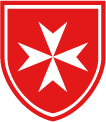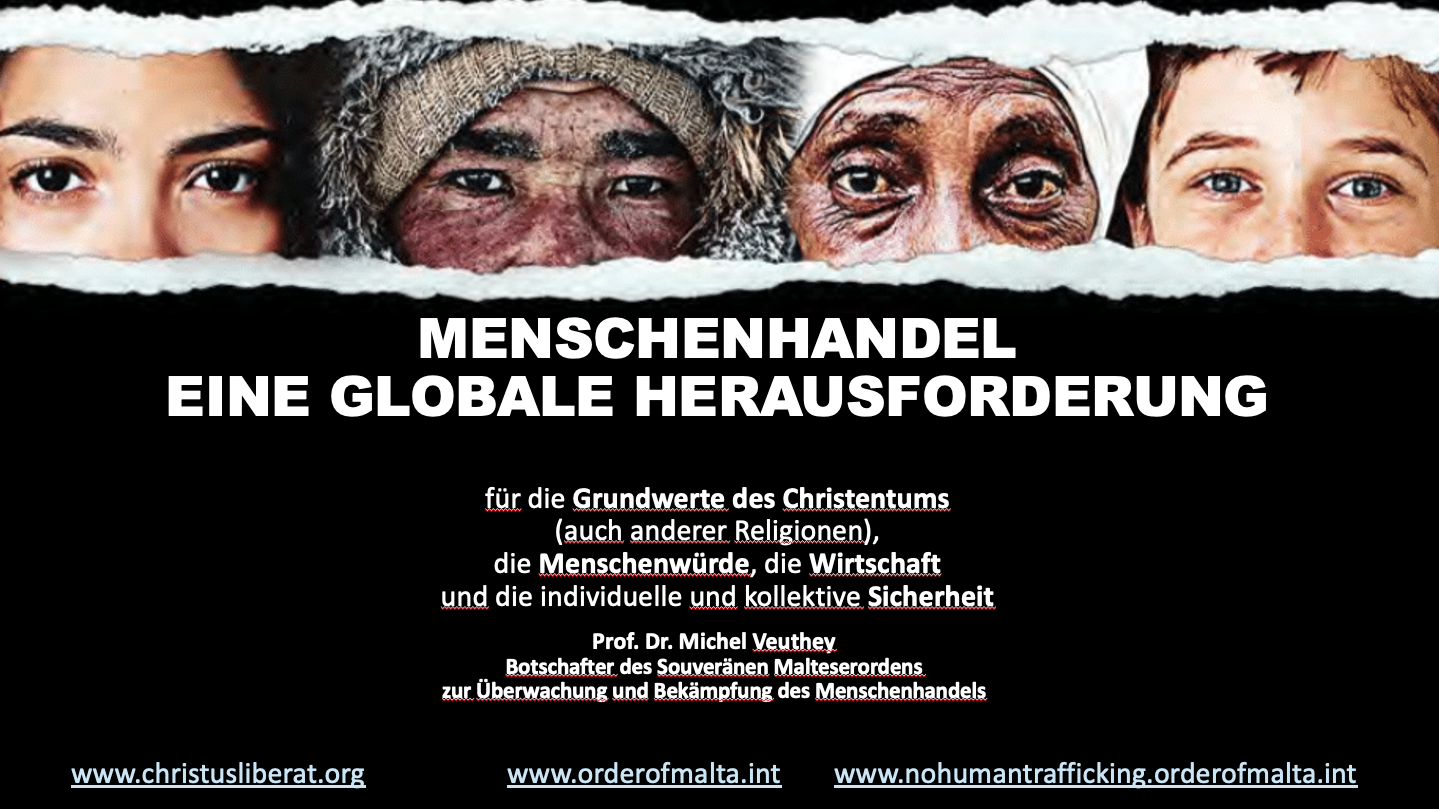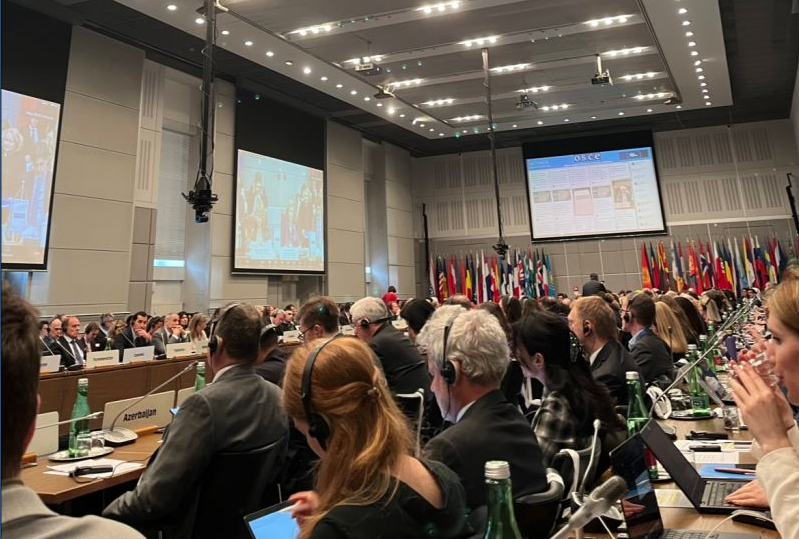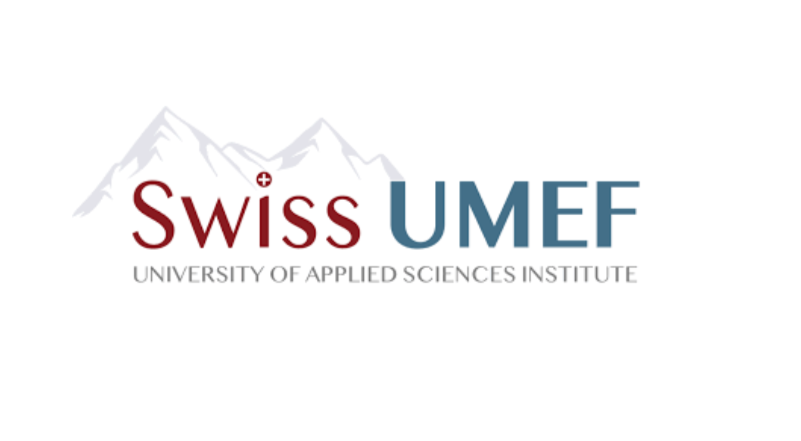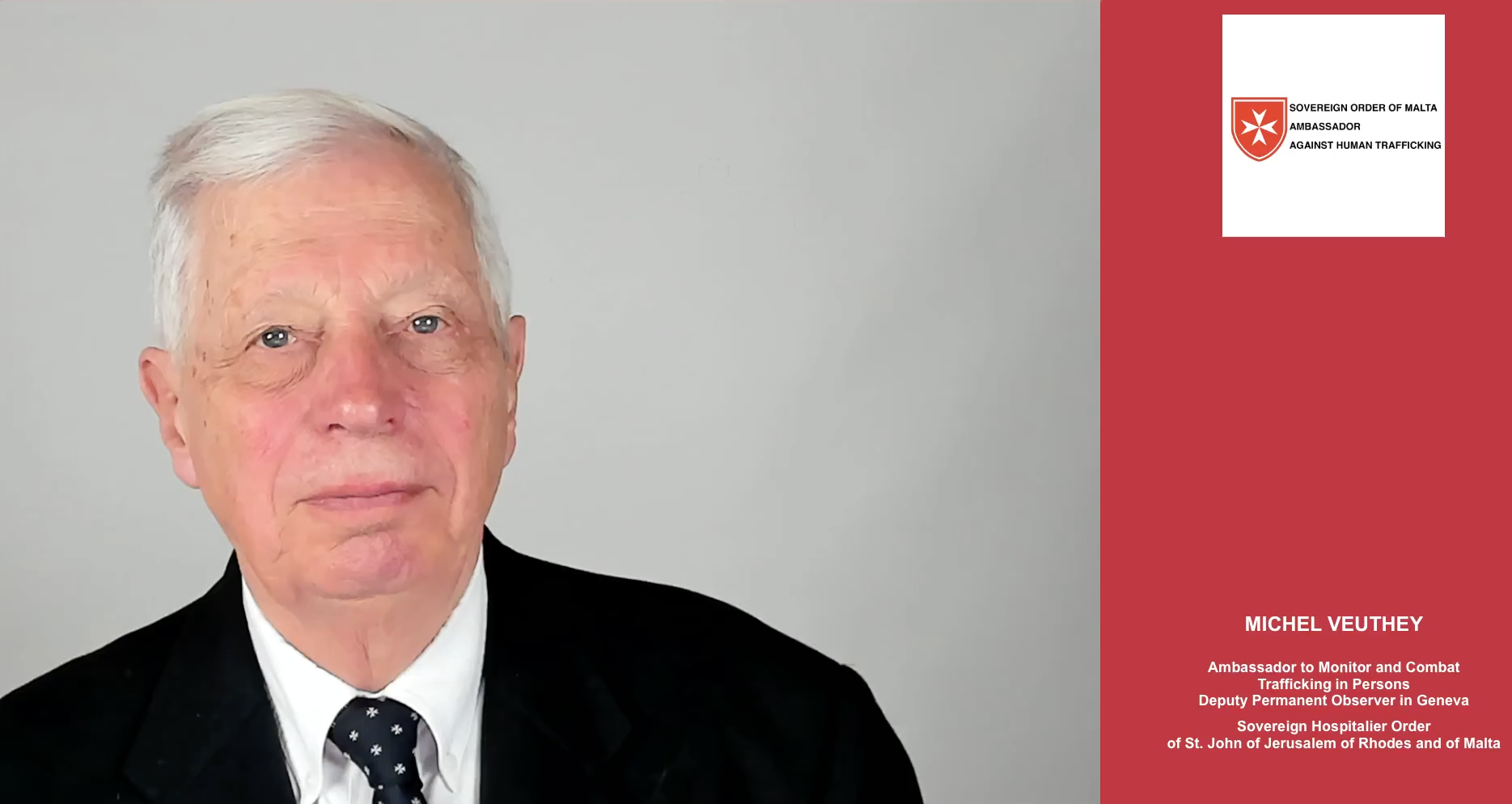ÖBiKo – STUDY DAY “FIGHT AGAINST HUMAN TRAFFICKING” FOR THE AUSTRIAN BISHOPS’S CONFERENCE
On March 8, 2021 the Order of Malta was invited by the Austrian Bishops’ Conference to present its action in the fight against human trafficking. You will find above the conference of Ambassador Michel Veuthey in German.
Human trafficking is an issue that is often invisible, yet present in all countries.
Human trafficking is a global challenge to the core values of Christianity (including other religions), human dignity, economics, and individual and collective security.
Human trafficking is simply based on the exploitation of people through physical and psychological violence or deception.
It takes several forms:
1) Forced labor: this involves women, men, children in industry, agriculture, fishing and so on.
2) Child recruitment, child soldiers,
3) Forced sex, prostitution, surrogacy,
4) Purchase and theft of children for adoption or abuse.
5) child pornography, mostly on the Internet
6) organ theft, for transplantation
7) Forced crime, for example begging, theft, drug trafficking, terrorism.
Millions of people are victims of human trafficking. Estimates of the United Nations, assume 40 million and more, including more than one million
from the European Union.
Half is sexual exploitation, 40 percent forced labor,
6 percent forced crime. 70 percent are
Women and 30 percent are men.
Some data. Over 800,000 slaves are believed to exist in 13 European countries alone – an increase of almost 400% over the previous year.
So you see Austria with 15,000 slaves,
the same number as in Switzerland.
THE CONTRIBUTION OF THE ORDER OF MALTA AGAINST HUMAN TRAFFICKING (2021)
(1) Raise awareness: Raise awareness through – its bilateral (110 states) network.
its multilateral (UN, European Union, etc.) diplomatic network.
A conference in Paris with international experts (Oct. 2019) to create new synergies.
(2) Medical and social programs through – its national associations.
its worldwide humanitarian organization “Malteser International”.
A pilot project in Lagos : ” Bakhita Center ” with Sr. Patricia Ebegbulem, SSL (Sisters of Saint Louis).
(3) Online training for caregivers (English www.cuhd.org) and partnership with universities.
Webster : “Use and abuse of high technology in human trafficking”.
Nice : Legal Clinic on the implementation of the European Union Directive against trafficking in human beings.
(4) Webinars on human trafficking (www.adlaudatosi.org) partly with German subtitles.
In collaboration with Sr. Mirjam Beike, Community of the Sisters of Our Lady of the Charity of the Good Shepherd (RGS)
(5) Participation in the World Day of Prayer against Human Trafficking (February 8, Feast of Saint Bakhita)
https://www.malteserorden.at/2021/02/…
FIND BELOW THE TEXT IN ENGLISH OF THE INTERVENTION:
Austrian Bishops’ Conference (ÖBiKo)
STUDY DAY “FIGHTING AGAINST HUMAN TRAFFICKING”
March 8, 2021
Intervention by Prof. Michel Veuthey
Ambassador of the Sovereign Order of Malta
to Monitor and Combat Trafficking in Persons
1 Thank you very much for your invitation to speak on this important topic.
Human trafficking is an issue that is often invisible and yet present in all countries.
Human trafficking is a global challenge to the fundamental values of Christianity (as well as of other religions), human dignity, the economy, and individual and collective security.
2 Human trafficking is based on the exploitation of people
through physical and psychological violence or deception.
3 Human trafficking takes various forms:
1) Forced labor: involving women, men, children in industry, agriculture, fishing, including worst forms of child labor
2) Child recruitment, child soldiers
3) Forced sex, prostitution, surrogacy
4) Purchase and theft of children for adoption or abuse.
5) Child pornography, mostly on the Internet.
6) Organ theft or illicit removal of human organs, for transplantation
7) Forced crime, for example, begging, theft, drug trafficking, terrorism.
4 Some data on human trafficking:
Millions of people are victims of human trafficking. The United Nations estimates the number at 40 million or more, including more than one million from the European Union.
50% is sexual exploitation, 40% forced labor, 6% forced crime.
70% are women and 30% are men.
5 Some data in Europe.
Over 800,000 slaves are believed to be in 13 European countries alone – an increase of nearly 400% over the previous year. Thus, Austria is seen with 15,000 slaves, as many as in Switzerland.
According to the Council of Europe Group of Experts on Action against Trafficking in Human Beings (GRETA) Third Evaluation Round (June 2020), Austria continues to be a destination and transit country for trafficked persons, mainly from Eastern Europe, Africa and Asia. The most common form of exploitation continues to be sexual exploitation, followed by labor exploitation, domestic servitude and forced begging, which often involves children. Compared to the period covered by the second GRETA report, there has been an increase in the number of suspected and identified victims of trafficking in the period 2015-2018. Austrian authorities also report a trend of using the Internet and technology to facilitate human trafficking.
Austria continues to be a destination and transit country for trafficked persons. Victims of human trafficking come primarily from Eastern Europe, Africa, and Asia. Third-country nationals accounted for 57% of all victims of sexual exploitation identified by the police in 2017. Sexual exploitation remains the most common form of exploitation, followed by labor exploitation, domestic servitude, and forced begging, which often involves children. Austrian authorities report a trend toward using the Internet and technology to facilitate human trafficking. Police data for 2017 show that in 74% of trafficking cases investigated, perpetrators used online infrastructures to groom, recruit, and solicit victims, such as through online ads, social media platforms, chat forums, and open-source messenger tools, as well as to control the victim through online video surveillance of homes and workplaces and cell phone tracking services. Communications between perpetrators and victims, as well as between the perpetrators themselves, have shifted to open-source messenger tools that are harder to detect. Profits are increasingly transferred through the use of bitcoin, prepaid credit cards, and other virtual payment methods.
On the next slide we have an interesting table that shows the differences between conventional and modern slavery:
Ancient slavery was more localized, while modern slavery is a globalized phenomenon.
In traditional slavery, there was legal ownership. In the new slavery, there is no legal property. Racial differences were significant in the past and are less significant today.
The old slavery was a long-term relationship, the cost of a slave was very high (several tens of thousands of euros). Today, slavery is illegal, the average price for a slave is less than 100 euros, which makes slavery generate the second largest profits of international crime, after drug trafficking. Globalization makes it very difficult for States to control slavery.
6 All trafficking figures are estimates. But here are the actual proven numbers of different images of abused children in Europe from 2014 to 2019 that appear on the Internet: 18 million different faces for Europe alone, according to the Association Meter, an online pedophilia observatory led by an Italian Catholic priest, Don Fortunato.
The 2020 annual report is stunning: it can be found on the https://associazionemeter.org
Please find herafter two images taken from the ASSOCIATION METER 2020 Annual Report:
7 Now we come to the main causes of human trafficking. The main cause is a culture of striving for maximum profit on the part of producers and consumers, a culture that devalues the dignity of the human being, the family, work and the environment.
This is the throwaway culture, that is, the thoughtless disposal of objects and people.
8 What is to be done? Allow me to suggest three approaches:
- First, raise awareness through information, education and training
- Second, share best practices, learn from each other, and
- Third, promote prevention, protection and rehabilitation measures.
Here below is a map of Europe with three different colors: it is an introduction of the situation of individual countries in relation to human trafficking. Green (with less high numbers). Here you can find Austria. In yellow you find higher numbers, for example Germany. In brown (worst) are Russia and other countries of Eastern Europe.
Actually, everything is connected.
That is why we are all concerned and called to action. There are connections between slave traders all over the world, this also applies to all countries, including Austria and Switzerland, where slaves also exist today.
9 Here are concrete approaches that could prevent trafficking, help protect and rehabilitate victims:
- Prevention through awareness-raising among families and communities of origin
- Identification. For this we need the training of police (face-to-face and online), customs, airline cabin crew, health personnel, prosecutors, judges, international civil servants, humanitarian workers, and even priests
- Protection from traffickers, and paradoxically protection from family members, and also protection from former victims who become perpetrators
- Rehabilitation: multidisciplinary, physical, psychological, professional, reintegration, spiritual
- Access to justice, criminal prosecution of traffickers and compensation to victims and then also
- Avoiding relapse into slavery through legal protection and professional training.
10 Religious communities can help on two levels:
- through public or targeted appeals to remind Governments and civil society of the need to respect the life and dignity of every human being, including interfaith action ;
- through concrete measures for the prevention of trafficking, for the identification, protection and physical, psychological and spiritual rehabilitation of the victims. These actions can be taken by religious organizations, communities, specialized congregations, especially Sisters, but also at the level of the individual parish.
- 11. One of the best documents I have read since I have been involved in this struggle was produced by the Holy See in January 2019, the “Pastoral Orientations on Human Trafficking”.” I am sure you are all familiar with them.
They capture the essence of the Church’s message:
- Protection and promotion of the dignity of every human being through prevention, care and rehabilitation
- Addressing the root causes of human trafficking through Catholic Social Teaching.
- Here is the abridged version of the table of contents of this valuable document, rooted in Catholic Social Teaching and action-oriented:
- This document sees as the cause of human trafficking the reduction of the human being to a “commodity” that can be freely exploited.
The orientations confirm that the family must be restored to the center of the economic model.
The role of the Church and faith is central in the fight against false gods, he said.
- Second comes the demand aspect.
We need to promote the criminalization of demand, especially with regard to sexual exploitation. We can no longer deny human trafficking and we must bring it to light. The refusal to acknowledge the terrible reality of human trafficking can no longer be tolerated. And we must identify and report human trafficking.
- The dynamics of human trafficking, a dirty business, is linked to the economy.
Very significant are working conditions and supply chains.
One must distinguish human trafficking from human smuggling,
because human smuggling is just the illegal assistance in crossing borders.
- Cooperation
Human trafficking is a complex phenomenon that requires broad cooperation, including between Government and civil society, including religious organizations.
The cooperation between Bishops and civil authorities is absolutely necessary.
14 The Sovereign Order of Malta also contributes to this common effort against human trafficking.
Since its foundation in the Holy Land 900 years ago, the Order of Malta has pursued two goals: defending the faith and helping the most vulnerable. Among the most vulnerable today are certainly the victims of human trafficking.
For this reason, in July 2017, the Order of Malta decided to appoint two Ambassadors to monitor and combat human trafficking: one based in Africa and one in Geneva. Romain de Villeneuve, my colleague based in Africa, has therefore supported the construction of the “Maison Bakhita”, which houses women returning from Europe who have been trafficked.
The national associations of the Order of Malta carry out humanitarian and social actions in Europe and around the world, especially to welcome and integrate migrants. And we are in the process of developing a strategy against human trafficking. This strategy involves an approach of governments, international organizations, NGOs (non-governmental organizations) and the private sector, and especially religious congregations working for the victims of human trafficking.
1) First, we try to raise awareness. We do that through our bilateral diplomatic network, also through our multilateral diplomatic network at the UN, in New York, Geneva, and Rome,
and at the European Union.
In October 2019, the Order of Malta hosted a first Conference in Paris with international experts to create new synergies. “How to better combat the sexual trafficking of women in West Africa and support their rehabilitation”. Numerous experts, including diplomats, academics, policy makers, representatives of European and Nigerian institutions, Catholic organizations, sister congregations and psychosocial counselors, participated.
Three roundtable discussions were held on “Prevention and Identification of Human Trafficking,” ” Protection of Victims in France and Europe,” and “Rehabilitation of Victims.” The aim of the discussions was to strengthen synergies and partnerships between the various actors on the ground and at the level of the international community in order to strengthen the fight against this terrible scourge, which has unfortunately reached unprecedented proportions. The conference focused primarily on Nigeria, where population growth and dire living and economic conditions are fueling human trafficking, which has also become a tactic of war.
2) Secondly, we run medical and social programs through our national associations, also through also our worldwide humanitarian organization “Malteser International”. We have also launched a pilot project in Lagos “BakhitaCenter” together with Sister Patricia Ebegbulem, Sister of Saint Louis (SSL).
3) Thirdly, we are doing a free online training for caregivers of victims of trafficking for the time being only in English in collaboration with a foundation based in Geneva (“Collège Universitaire Henry Dunant”). This practical training is completely free and open to all You are welcome to visit the website: www.cuhd.org.
Then we maintain partnerships with universities:
- Webster University (Geneva) “Use and Abuse of Hig-Tech in Human Trafficking.”
- and also with Nice University (Faculty of Law – Institut de la Paix et du Développement – IdPD) with a research program “Legal Clinic on the Implementation of the 2011 European Union Directive on Combating Trafficking in Human Beings“.
4) Fourth, since October 2020 we organize webinars on human trafficking. These are ongoing and also accessible free of charge, partly with English, French and German subtitles on the following website: www.adlaudatosi.org. We do this in collaboration with Sister Mirjam Beike, of Congregation of Our Lady of Charity of the Good Shepherd (RGS). She now lives and works in Geneva.
5) Last but not least, we participate in the World Day of Prayer against Human Trafficking on February 8, namely on the feast day of Saint Bakhita. The Order of Malta in Austria has also participated.
SOURCES
15 Lastly, I would now like to recommend that you consult the sources,
which are made available to you in this presentation:
First, sources from the Austrian Government:
- Chancellor’s Office
- Federal Ministry for International Affairs
- Federal Ministry of the Interior
- and Labor inspection.
Then sources of the Catholic Church:
Not only Pope Francis, but also the Migrants and Refugee Section, the Pontifical Academy of Social Sciences, the Santa Marta Group: a group of Bishops and police against human trafficking that is very active.
Then networks of religious communities, such as:
- SOLWODI (Solidarity with Women in Need)
- RENATE (Christian organizations in the fight against human trafficking and exploitation)
- COATNET (Christian Organizations Fighting Human Trafficking), led by CARITAS.
- Talitha Kum (International Network Against Human Trafficking).
One last example in Australia: the Archbishop of Sydney has set up an anti-trafficking task force, which is doing very interesting work. John McCarthy, QC, a lawyer, is the chairman. The website is quite interesting. A great role model!
UN
Then the United Nations (UN), in particular the UNODC based in Vienna:
United Nations Office on Drugs and Crime
In January 2021, UNODC highlighted the following:
“The percentage of children who are trafficked has tripled in the last 15 years, while the percentage of boys has increased fivefold.”
The UNODC recently published a worldwide report (“Global Report on Trafficking in Persons”) on human trafficking.
EUROPE
Now let’s refer to some sources from Europe :
The Council of Europe, based in Strasbourg, adopted in 2005 a very interesting Convention on Action against Trafficking in Human Beings.
And the States Parties to the Convention make a threefold commitment:
- Prevent human trafficking,
- Protect victims’ rights,
- Prosecute perpetrators
For its part, the European Union adopted a “Directive 2011/36/EU on preventing and combating trafficking in human beings and protecting its victims” in 2011.
This is also a very interesting legal instrument against human trafficking.
The last organization I would like to mention is the OSCE, the Organization for Security and Cooperation in Europe. Like the EU, the OSCE has appointed a Special Representative and Coordinator for Combating Trafficking in Human Beings.
The OSCE regularly publishes very interesting reports on human trafficking.
MEDIA
In addition to these written sources, one can find interesting films on the subject.
For example:
- “Kindermachen” (a Swiss film in German by Barbara Burger, 2017)
- “October Baby” (2011)
- “Whistleblower” (a true story, 2010).
Very documented are ARTE.tv’s reports on historical and current slavery:
· “ Menschenhandel – Eine kurze Geschichte der Sklaverei” (A Short History of Slavery)
· “Slavery Routes” (“Les routes de l’esclavage ») (2018)
· “What does modern slavery mean? ” (“Was bedeutet ‘moderne Sklaverei’?”)
(Australia takes big business to task). In Australia, the Parliament, Senate and House of Representatives pass the Modern Slavery Bill 2018. The bill is intended to drive the fight against modern slavery. Major national and multinational companies are to commit to disclosing information on working conditions.
Together it is possible to break the chains of slavery!
At the end of the last century, in 1997 and 1998, two coalitions achieved a result that no one expected:
– In 1997, the International Campaign to Ban Landmines achieved the adoption of the Ottawa Convention...
– In 1998, the Coalition for the International Criminal Court (ICC) pushed through the adoption of the Rome Statute.
It is a similar coalition that we need to achieve the abolition of the modern slavery.
What we are looking for is not a new legal instrument nor a new international criminal court.
We need to mobilize public awareness to effectively and fully implement existing international treaties and existing national laws, first through national courts, and also to recognize that human trafficking is a crime against humanity. Let’s end modern slavery together.
That’s all for today.
I would be happy to answer questions an
